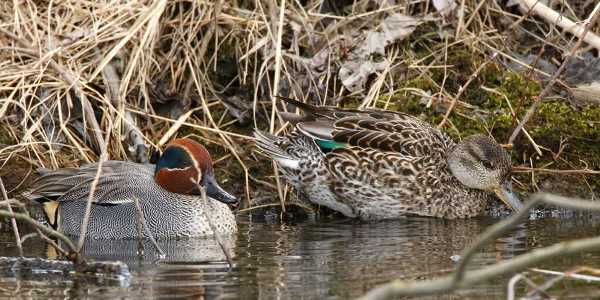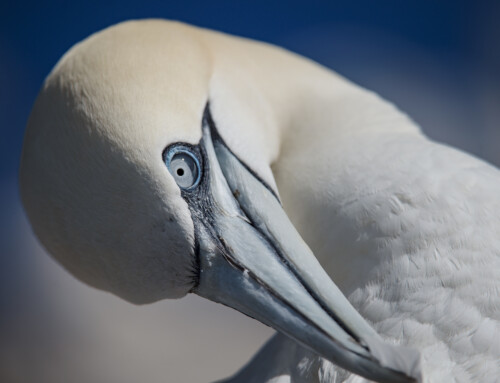Favouring Beavers promotes biodiversity, including waterbirds
LINKED PAPER
The effect of beaver facilitation on Common Teal: pairs and broods respond differently at the atch and landscape scales. Nummi, P., Suontakanen, E.-M., Holopainen, S. & Väänänen, V.-M. 2018. IBIS.
DOI: 10.1111/ibi.12626. VIEW
Effect of the Beaver comeback
Beavers (Castor fiber) are returning to many parts of their former range in Europe, from where they were decimated hundreds of years ago. The most recent reintroduction is in Scotland. Beavers (C. fiber and C. canadensis) are ecosystem engineers which create inundated areas in creeks and ponds with their dams.

Beaver families often shift their residence every 3-5 years. And, Beaver patches undergo succession from terrestrial to aquatic habitat and back thereby increasing landscape heterogeneity. With ecosystem engineering, Beavers also act as facilitators for various species, such as bats and waterbirds. They sometimes even facilitate whole species communities.
In the boreal region, patch creation by Beavers has been found to especially benefit Common Teal Anas crecca, as both Teal pairs and broods rapidly occupy newly formed Beaver flowages. Behind this preference lie both food and habitat structure: compared with non-disturbed boreal ponds, Beaver ponds provide more invertebrate food and have shallower shores which are suitable for foraging. Not only Teal densities tend to be higher in Beaver ponds, but also their duckling survival is elevated with ample food there.
Environment of Teal pairs and broods
We studied whether scale affects how Teal pairs and broods are influenced by Beaver inundations. We presumed that ducks may experience their environment differently according to age. We investigated how flying Teal pairs and flightless broods – which differ in their mobility – respond to environmental variation at patch versus landscape scales.
The patches in our study (0.1–50 ha) are easily covered by both breeding pairs and broods within tens of minutes or 1–2 hours of swimming. In contrast, shifting between the most distant lakes within each landscape of our study (40–50 km2) would only take a few minutes for the flying pairs, but at least 15 hours (but most likely 1–3 days) for the non-flying broods. Duck pairs therefore typically have home ranges comprising many small wetlands and they travel a few kilometers between their foraging patches.
We surveyed two landscapes situating in southern Finland during 1988–2014. The Evo area is with Beavers while the Nuuksio is not. In the Beaver landscape we knew when the ecosystem engineers occupied and left a certain lake. At the patch scale, we had an experiment-like situation that bird numbers could be compared before and during Beaver flooding. In the landscape scale, we used 20 years data from the Beaver and non-Beaver landscapes. In all cases we studied Teal pair and brood densities as well as breeding success (broods per pair).
Scale does matter
Interestingly, we found that Teal broods responded strongly to Beaver flooding. Their densities were over 90% higher during Beaver inundation than before flooding. Although Teal pairs did not respond distinctly at the patch level, both Teal pair and brood densities were significantly higher in the Beaver than in the non-Beaver landscape. The number of broods per pair was higher in both patch and landscape scales.

At least two mechanisms could bring about the pattern we observed. Firstly, although pairs might use Beaver ponds for foraging, they very likely encompass many small wetlands in their home range, and spend only part of their time in the Beaver flowages. This has been shown for radio-tracked Mallards, Anas platyrhynchos, with home ranges of 230 ha that include e.g. seasonal wetlands. Teals have not been followed using radio telemetry but the home ranges of Teal pairs are approximately the same size as those of Mallard. Teal broods are less mobile than adults. They may spend all of their time in the optimal Beaver ponds, once they have been discovered; the home ranges of comparable Mallard broods were 10–15 ha.
Secondly, seasonal wetlands may have diluted the Beaver flowage effect in spring. Seasonal wetlands created by melting snow have been shown to be suitable for duck foraging during the pairing season. When a large number of flooded shores and vernal pools are available, ducks may use both Beaver flooded and melting snow flooded areas. The Teal pairs, thus, did not show a significant preference to Beaver flooded areas.
Beaver in wetland restoration
At our Beaver landscape, it has been found that Teal broods are concentrated in the few existing Beaver patches, while pairs are less so. It is also noteworthy that out of a plethora of factors such as weather and predation pressure, the amount of Beaver flooding is the most important factor affecting yearly Teal production in the area.

Considering that 60–90% of European wetlands were lost during the last century, there is great need for wetland restoration. From geomorphological, hydrological and ecological aspects introducing Beavers has the potential to be a mechanism for wetland restoration. Beavers are known to enhance biodiversity, and our data support earlier findings which consider introducing Beavers as a feasible and economic way of restoring riparian landscapes.
References
Holopainen, S., Nummi, P. & Pöysä, H. 2014. Breeding in the stable boreal landscape: Lake habitat variability drives brood production in the teal (Anas crecca). Freshwat. Biol. 59: 2621–2631. VIEW
Naiman, R.J., Johnston, C.A. & Kelley, J.C. 1988. Alteration of North American streams by beaver: the structure and dynamics of streams are changing as beaver recolonize their historic habitat. BioScience 38: 753–762. VIEW
Nummi, P. & Holopainen, S. 2014. Whole-community facilitation by beaver: ecosystem engineer increases waterbird diversity. Aquatic Conserv. 24: 623–633. VIEW
Stringer, A.P & Gaywood, M.J. 2016. The impacts of beavers Castor spp. on biodiversity and the ecological basis for their reintroduction to Scotland, UK. Mammal Review 46: 270–283. VIEW
Image credit
Featured image: Common Teal Anas crecca pair © Veli-Matti Väänänen
Blog posts express the views of the individual author(s) and not those of the BOU.
If you want to write about your research in #theBOUblog, then please see here.





